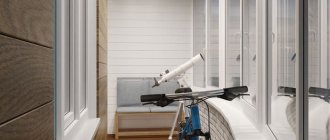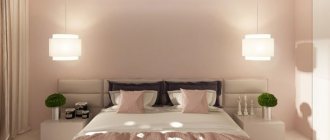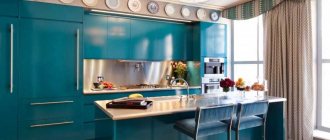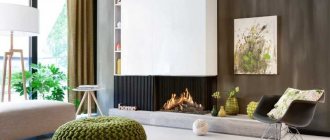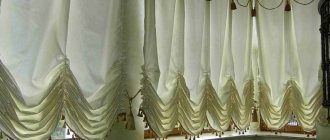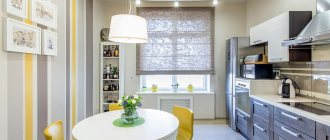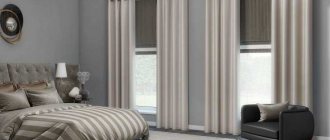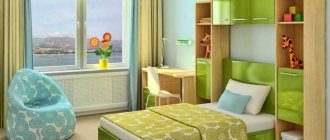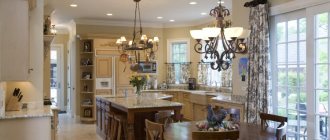First example: uniform style
The individuality of the interior is created primarily by well-chosen textile design. One of the main rules of textile decoration is the unity of the image - you can use one pattern or a combination of several colors and patterns, the main thing is that they are all in the same style.
Window decor traditionally refers to textile design, and therefore it needs to be decorated in accordance with the fabric interior of the room. In this case, the blinds will also be part of this textile ensemble, and must be consistent in the color and texture of its other elements.
Curtains and blinds in a single gray color scheme
Do not overdo it in selecting curtains and blinds of similar colors; remember that the differences between the parts of the window decoration give greater depth and expressiveness to the whole. Use combinations of single-color curtains and blinds with a pattern, or vice versa - single-color blinds and curtains with a print
Second example: more room to adjust sunlight
Roller blinds provide good darkening performance, but sometimes the main requirement for a room is the uniformity of light dispersion. And vertical blinds cope best with this task. Most often, such a function of blinds is needed in living rooms. This room usually has the largest windows in the house, and this fact needs to be played up. Everyone who visits your home will appear in the living room, and to create a feeling of comfort in the house, the owners need to try. Combine vertical fabric blinds with curtains of muted shades; this will add softness and tranquility to the interior, relax your attention and promote comfortable communication with guests.
Vertical fabric blinds and curtains for the living room in a soft cream color
Another type of blinds that provides uniform adjustment of the light flux are Zebra roller blinds.
Fourth example: modern equality
Modern interior styles challenge the traditions of the classics. This also applies to the usual window design, when thicker curtains frame the middle of the window, curtained with light tulle. You can experiment here and use thick roller blinds to “balance” the curtains.
Blinds and curtains of the same density are a good option for a modern interior
Combinations of light curtains and thick blinds can also look good in a modern interior, but with such design solutions it is very difficult to make a mistake and ruin the entire look of the room
Why roller blinds
Roller curtains are coated with a special solution that prevents them from fading, protects them from moisture and dust, which increases the service life of the curtains. In addition, they also have positive properties:
- Compactness. The curtains conveniently roll up, taking up minimal space and completely opening the window sill, where you can place, for example, flowerpots.
- Practicality. Rolls are easy to clean. The mechanism itself is quite simple and rarely breaks down.
- Permeability. Depending on the fabric, curtains can protect from 15-100% of sunlight.
- Diversity. The modern curtain market offers a variety of types of curtains that can highlight any interior and satisfy the desires of every person. They are made from several types of materials: linen, polyester, silk, cotton and others. They come in plain colors, with various patterns and photo prints. In addition, there are roller blinds designed specifically for rooms with high humidity, and heat-insulating ones with an anti-reflective surface.
You may also be interested in: Which fabric to choose for tulle?
Rolled curtains are in many ways reminiscent of Roman curtains: they take up minimal space and volume, and fold comfortably and tightly. They differ only in the lifting mechanism. If Roman curtains are rolled up in stages, then the curtain from the roll rises on a shaft, which is fixed at the top of the window frame.
To get a beautiful combination of roller blinds and tulle, curtains should be made from natural fabrics of moderate density. Synthetic textiles with frequent darkening and a ribbed structure are only suitable for matte curtains in soft shades. Non-standard combinations in bedrooms and living rooms should be avoided.
The only exception is the kitchen, where free style combinations are allowed. The best solution is matte organza options, which can create a beautiful “frame” around the edges of the curtains, smoothing out all the corners.
Save
Save
Sixth example: noble tree
Wooden blinds look better than any other next to curtains, and this is no wonder - after all, in interiors from time immemorial, textiles have been combined with wood - sofas, upholstered armchairs, tapestries with wooden baguettes, tables with tablecloths, beds with bedspreads... Horizontal wooden blinds and luxurious curtains in a classic interior will correspond to all the best design traditions. In a modern interior, such blinds can be combined with lighter plain curtains, muslin, or in eco-style - with canvases made from natural materials (linen, cotton).
Wood and satin curtains with drapery are aristocratic luxury that perfectly controls the lighting of the room
Translucent roller blinds in the interior
PreviousCurtainsVariety of rods for curtains in the bathroom
Next
CurtainsThe use of black curtains in the interior of the living room, bedroom, hall and kitchen
Seventh example: together, but apart
You can combine curtains and blinds by decorating different windows from the same group with them separately. For example, to create a cozy look and reliable sun protection in the dining room, cover the side windows with long curtains and decorate the central window with roller blinds. Thus, you will visually highlight the center of the room, and the sunlight transmitted by the blinds when open will help you with this.
Separate use of curtains and blinds in one room
A similar technique can be used in the bedroom if the windows are located above the bed or opposite it, as well as in any other room. The main condition is that the windows should be in the center, otherwise adjustments will have to be made to the symmetrical structure consisting of curtains and blinds so that the overall design does not look ill-conceived.
Separate use of curtains and blinds on one group of windows looks especially good in a bay window
Fabric curtains
Creating comfort in your home is not an easy task. Accessories will help create an atmosphere of warmth in a modern home.
This year, the combination of long fabric curtains with technologically advanced roller blinds or Roman blinds is popular. This looks especially good in spacious kitchens that also have a dining area.
For studio apartments, Japanese curtains or curtains with photo prints would be an interesting design solution.
Japanese curtains, consisting of several wide strips of fabric, extend all the way to the floor and are weighted at the bottom. The straight lines of such curtains fit perfectly into the fashion trends of 2021. Fold-free canvas is suitable for both interesting textured fabrics and a variety of prints.
Also, in addition to the window, floor-length curtains decorate the passages in the kitchen and even the walls. They do not serve any function, they are simply decoration.
It should be remembered that this year minimalism prevails. It is worth abandoning complex structures. Simple straight lines without lambrequins and bows are in fashion.
You should not make curtains in an expensive-rich style. This is no longer relevant for a long time. Therefore, it is better not to include multi-layer designs made of tulle, thick curtain fabrics and tassels with bows in the interior.
Large bright prints look beautiful on strict minimal forms.
Thus, everything returned to the minimalism and technology of the 70s. However, there are some peculiarities here too.
Firstly, the choice of material leans towards natural textured fabrics such as linen or large-weave cotton.
Secondly, natural or pastel colors predominate: beige, olive, brown, milky white.
Thirdly, we do not ignore the manufacturability and safety of curtains. Near open hobs, you should not use long curtains, especially those made of synthetic fabrics.
And most importantly, choose for your home what you like. Everyone has an individual idea of comfort and convenience.
Eighth example: confrontation
Sometimes it happens that there is no dominant color in the interior of a room, because the designer’s imagination suggested an interesting color option - the use of two equally contrasting colors to create an interesting and unusual image. Such duality can be emphasized not only by color, but also by the shape of furniture and decorative elements. And using a contrast between blinds and curtains in this interior would, of course, be a logical solution. One color against another, curtains against blinds - what could be more attractive than such a “competition”?
Whatever blinds you choose, you always have the opportunity to create a combination of multi-colored slats in one product, which will look original and unusual.
The combination of curtains and blinds helps to play up the idea of a two-color interior
Distribute the two main colors of the interior in the window design so as to shift the accents in the direction you need - leave a calmer, neutral color for the blinds, and give a bright, saturated color to the curtains. In this situation, the curtains will dominate this pair, which will give the room coziness
Choosing material for kitchen curtains
Curtains in the kitchen, unlike other rooms, get dirty much faster due to soot, grease and moisture that are released during cooking. Therefore, there is no point in hanging heavy and dense fabrics such as velvet there. Here, fabrics made from mixed fibers would be more appropriate: polyester combined with cotton or viscose-based fabric. For the kitchen, you can use fabrics with special fire-resistant impregnation. It is better not to hang very light fabrics that rise with a slight breeze for kitchen safety reasons. If your stove is located close to a window, then such a curtain may cause a fire. A very good option for kitchen curtains are linen curtains with lavsan. Linen is responsible for environmental friendliness, and lavsan for shine and lightness.
Related article: Gerda doors: review of steel entrance doors
Ninth example: merge with the wall
Any designer will tell you that you cannot match curtains to the color of the wallpaper in the room, as this will deprive the interior of its relief and make it flat and boring. This does not apply to blinds used in conjunction with curtains - after all, the intermediate link between the wall and the window is the curtains, breaking up their monochromatic appearance. When closed, the blinds become like an extension of the wall and create a feeling of protection from the outside world, from the street with its bustle, prying eyes and bad weather. This design option looks calm and discreet, and can be used in the living room, bedroom or nursery.
For this technique, it is best to choose blinds that fit tightly to the window - cassette, interframe or pleated blinds.
Pleated blinds and curtains of the same color in the interior of the room
Tenth example: contrast detail
Blinds can be not only a functional part, but also the highlight of a room. And the curtains framing the window will fulfill the task of creating coziness. Thus, we get a comfortable room with bright, attractive windows, the main “character” of which is the blinds. To do this, it is absolutely not necessary to look for a product with bright red or light green slats. They may well be of a restrained color - for example, dark brown or pale green. The essence of the design technique is to create a textile window design that practically does not stand out from the general appearance of the room, but does not completely merge with it (so as not to lose texture); at the same time, the color of the window blinds should be contrasting with the textiles. The less colorful the interior of your room, the more noticeable the difference between the color of blinds and curtains will be.
If you hang white curtains in a bright room with a light coral or beige tint, even light walnut-colored wooden blinds will look great here
Clear lines of blinds against a light romantic background of the room
Rules for combining curtains and blinds
- The following combinations are suitable for the bedroom: horizontal wooden blinds and multi-layer curtains, roller blinds and light airy curtains;
- Wooden, roller and multi-textured blinds are best combined with fabric curtains;
- Aluminum and plastic blinds do not combine so well with curtains, but if you wish and have a little imagination, you can always choose good combinations for the kitchen, bathroom, corridor and other small rooms;
- If the windows face south and there is always enough light in the room, choose blinds and curtains that, individually or together, provide maximum darkness;
- If it is expected that curtains will dominate the importance of blinds for the interior, choose blinds in calm, restrained shades;
- Cover large window openings with vertical and roller blinds, and for small windows choose mini roller blinds, as well as horizontal cassette UNI, inter-frame blinds - they will look good with short or arched curtains;
Pros of using blinds in the kitchen
What is the difference between blinds and simple roller blinds, and why do most consumers want them in the kitchen? It's time to find out.
Let's highlight the main advantages of blinds:
- convenient lighting adjustment through easy settings;
- opening and closing the window, setting the tilt position by simply turning the handle;
- preventing the sun's rays from hitting the surface of the kitchen unit;
- ease of choosing blinds for a specific window opening size;
- compactness, which is suitable for small kitchens.
In addition to the listed advantages, it is worth noting the variety of colors of blinds and a large selection of materials for their manufacture.
Modern blinds for the kitchen are easy to choose for interior decoration. It is easy to remove dirt from them using a regular damp cloth. As for roller blinds, they can be washed with any mild cleaning agent.
